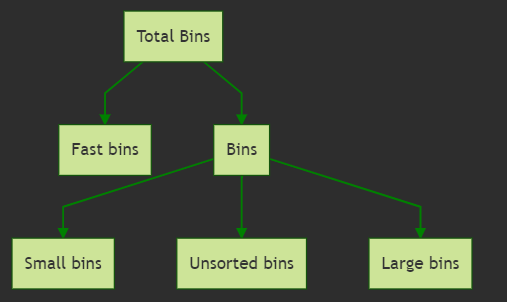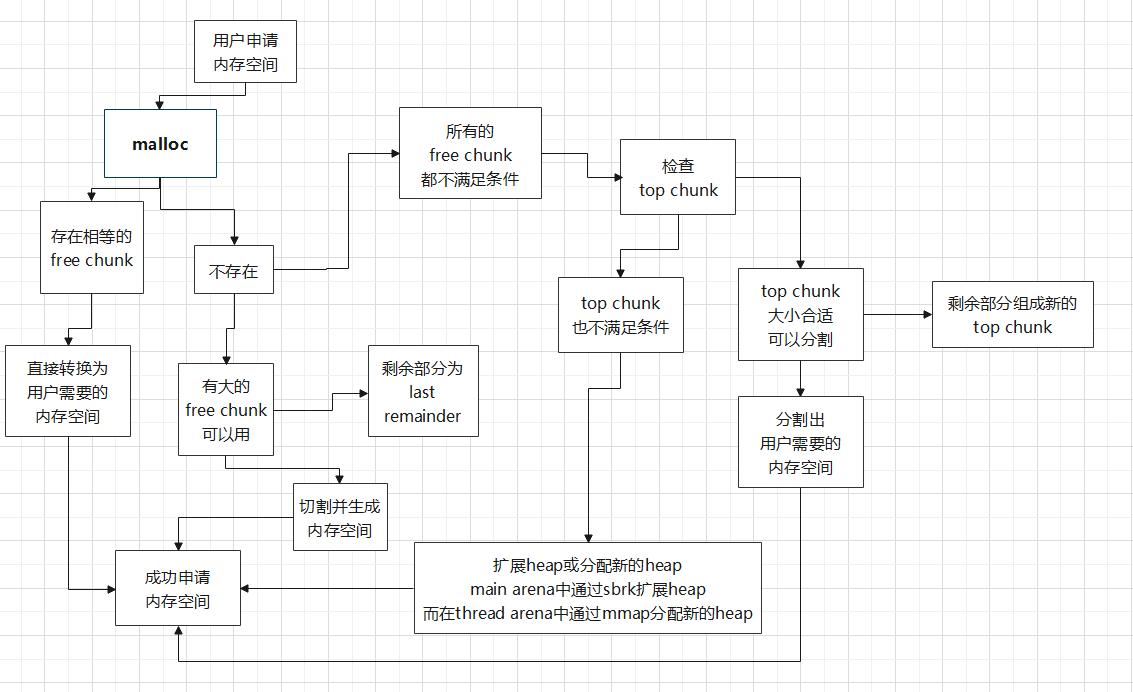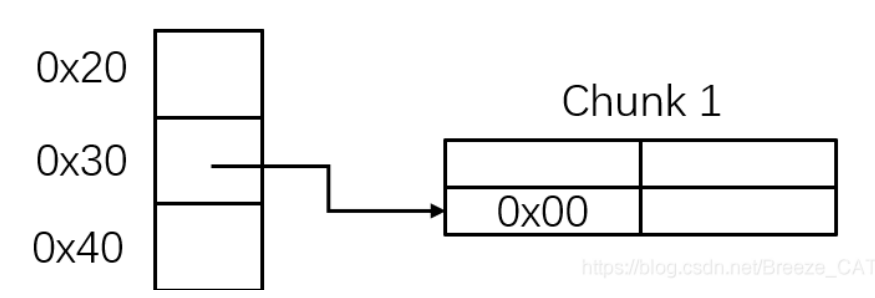Ptmalloc算法:UAF
堆利用中较为常见的漏洞,利用了“free”函数本身的缺陷,对已经置空的指针进行操作
UAF一般有以下几种情况:
- 内存块被释放后,其对应的指针被设置为 NULL , 然后再次使用,自然程序会崩溃
- 内存块被释放后,其对应的指针没有被设置为 NULL ,然后在它下一次被使用之前,没有代码对这块内存块进行修改,那么程序很有可能可以正常运转
- 内存块被释放后,其对应的指针没有被设置为 NULL,但是在它下一次使用之前,有代码对这块内存进行了修改,那么当程序再次使用这块内存时,就很有可能会出现奇怪的问题
UAF漏洞主要是后两种,被置空的指针被称为“dangling pointer”
数据结构bins
简单来说bin就是free chunk的容器
ptmalloc 把大小相似的 chunk,用双向链表连接起来,这样就形成了一个 bin,ptmalloc 一共维护了 128 个这样的 bin,并使用数组来存储这些 bin 如下:(32位)

从第2个到第64个bin是small bin,small bin中的chunk大小相同,small bin是一个双向链表
在某一条bin中(chunk大小相同)按照「先入先出」(FIFO 的规则)进行排序,也就是说,刚被释放的放在前面
bins分类:fast bin,small bin,unsorted bin,large bin

bin链都是由当前线程的arena管理的
Fast bin
Fast bin可以看着是 small bins 的一小部分 cache ,设计初衷就是进行快速的小内存分配和释放
概念:chunk 的大小在32字节~128字节(0x20~0x80)的 chunk 称为“fast chunk”(大小不是 malloc 时的大小,而是在内存中 struct malloc_chunk 的大小,包含前2个成员)
特征:
- Fast bin是 单向链表 只有 FD 指针
- Fast chunk 不会对其他 free chunk 进行合并
- 系统将属于 Fast bin 的 chunk 的 PREV_INUSE 位总是设置为1
- Fast bin 中无论是添加还是移除 fast chunk,都是对“链表头”进行操作,而不会对某个中间的 fast chunk 进行操作
使用次序:后入先出(可以类比一下栈)
- 释放时:将此 chunk 插入到该 Fast bin 的“链表头”
- 申请时:优先申请 Fast bin “链表头”处的 chunk(从前向后申请)
通常情况下:
- 如果chunk大小 小于“0x40(32位) / 0x80(64位)”,那么该chunk会直接存入Fast bin
- 如果内存请求 小于“0x40(32位) / 0x80(64位)”,那么程序会优先在 Fast bin 中查找
1
2
3
4
5
6
7
8
9
10
11
12
13
14
15
16
17
18
19
20
21
22
23
24
25
26
27
28
29
30
31
32
33
34
35
36
37
38
| #include<stdio.h>
#include <stdlib.h>
int main()
{
unsigned int *p1,*p2,*p3,*p4,*p5,*p6;
unsigned int *a,*b,*c;
p1=malloc(0x50);
printf("%p\n",p1-4);
p2=malloc(0x50);
printf("%p\n",p2-4);
p3=malloc(0x50);
printf("%p\n",p3-4);
p4=malloc(0x50);
printf("%p\n",p4-4);
p5=malloc(0x50);
printf("%p\n",p5-4);
p6=malloc(0x50);
printf("%p\n",p6-4);
free(p1);
free(p3);
free(p5);
printf("--------------\n");
printf("fastbin:%p -> %p -> %p\n",p5-4,p3-4,p1-4);
a=malloc(0x50);
b=malloc(0x50);
c=malloc(0x50);
printf("--------------\n");
printf("%p\n",a-4);
printf("%p\n",b-4);
printf("%p\n",c-4);
printf("--------------\n");
return 0;
}
|
1
2
3
4
5
6
7
8
9
10
11
12
13
14
| ➜ [/home/ywhkkx/桌面] ./test
0x56000683a000
0x56000683a470
0x56000683a4d0
0x56000683a530
0x56000683a590
0x56000683a5f0
--------------
fastbin:0x56000683a590 -> 0x56000683a4d0 -> 0x56000683a000
--------------
0x56000683a590
0x56000683a4d0
0x56000683a000
--------------
|
Small bin
small bins 中一共有 62 个循环双向链表,每个链表中存储的 chunk 大小都一致
使用次序:先入先出(可以类比一下食堂排队)
- 释放时:将此 chunk 插入到该 Small bin 的“链表头”
- 申请时:优先申请 Small bin “链表尾”处的 chunk(从后向前申请)
1
2
3
4
5
6
7
8
9
10
11
12
13
14
15
16
17
18
19
20
21
22
23
24
25
26
27
28
29
30
31
32
33
34
35
36
37
38
39
| #include<stdio.h>
#include <stdlib.h>
int main()
{
unsigned int *p1,*p2,*p3,*p4;
unsigned int a,b,c;
p1=malloc(0x80);
p2=malloc(0x100);
free(p1);
p3=malloc(0x40);
p4=malloc(0x100);
a=p3+0x10;
p1=malloc(0x80);
p2=malloc(0x100);
free(p1);
p3=malloc(0x40);
p4=malloc(0x100);
p1=malloc(0x80);
b=p3+0x10;
p2=malloc(0x100);
free(p1);
p3=malloc(0x40);
p4=malloc(0x100);
c=p3+0x10;
printf("smallbin:0x5555%x -> 0x5555%x -> 0x5555%x\n",c,b,a);
p1=malloc(0x30);
printf("chunk1:%p\n",p1-4);
p2=malloc(0x30);
printf("chunk2:%p\n",p2-4);
p3=malloc(0x30);
printf("chunk3:%p\n",p3-4);
return 0;
}
|
1
2
3
4
5
| ➜ [/home/ywhkkx/桌面] ./test
smallbin:0x5555a66515b0 -> 0x5555a6651300 -> 0x5555a6651050
chunk1:0x5580a6651050
chunk2:0x5580a6651300
chunk3:0x5580a66515b0
|
Large bin
large bins 中一共包括 63 个 bin,每个 bin 中的 chunk 的大小不一致,而是处于一定区间范围内
- 概念:大于等于1024字节(0x400)的chunk称之为large chunk,large bin就是用于管理这些largechunk的
- large bin链表的个数为63个,被分为6组
- largechunk使用 fd_nextsize、bk_nextsize 连接起来的
- fd_nextsize:指向前一个与当前chunk大小不同的第一个空闲块,不包含 bin 的头指针
- bk_nextsize:指向后一个与当前 chunk 大小不同的第一个空闲块,不包含 bin 的头指针
- 合并操作:类似于small bin
1
2
3
4
5
6
7
8
9
10
11
12
13
14
15
16
17
18
19
20
21
22
23
24
25
26
27
28
29
30
31
32
33
34
35
36
37
38
39
40
41
42
43
44
45
46
| #define largebin_index_32(sz) \
(((((unsigned long) (sz)) >> 6) <= 38) \
? 56 + (((unsigned long) (sz)) >> 6) \
: ((((unsigned long) (sz)) >> 9) <= 20) \
? 91 + (((unsigned long) (sz)) >> 9) \
: ((((unsigned long) (sz)) >> 12) <= 10) \
? 110 + (((unsigned long) (sz)) >> 12) \
: ((((unsigned long) (sz)) >> 15) <= 4) \
? 119 + (((unsigned long) (sz)) >> 15) \
: ((((unsigned long) (sz)) >> 18) <= 2) \
? 124 + (((unsigned long) (sz)) >> 18) \
: 126)
#define largebin_index_32_big(sz) \
(((((unsigned long) (sz)) >> 6) <= 45) \
? 49 + (((unsigned long) (sz)) >> 6) \
: ((((unsigned long) (sz)) >> 9) <= 20) \
? 91 + (((unsigned long) (sz)) >> 9) \
: ((((unsigned long) (sz)) >> 12) <= 10) \
? 110 + (((unsigned long) (sz)) >> 12) \
: ((((unsigned long) (sz)) >> 15) <= 4) \
? 119 + (((unsigned long) (sz)) >> 15) \
: ((((unsigned long) (sz)) >> 18) <= 2) \
? 124 + (((unsigned long) (sz)) >> 18) \
: 126)
#define largebin_index_64(sz) \
(((((unsigned long) (sz)) >> 6) <= 48) \
? 48 + (((unsigned long) (sz)) >> 6) \
: ((((unsigned long) (sz)) >> 9) <= 20) \
? 91 + (((unsigned long) (sz)) >> 9) \
: ((((unsigned long) (sz)) >> 12) <= 10) \
? 110 + (((unsigned long) (sz)) >> 12) \
: ((((unsigned long) (sz)) >> 15) <= 4) \
? 119 + (((unsigned long) (sz)) >> 15) \
: ((((unsigned long) (sz)) >> 18) <= 2) \
? 124 + (((unsigned long) (sz)) >> 18) \
: 126)
#define largebin_index(sz) \
(SIZE_SZ == 8 ? largebin_index_64(sz) : MALLOC_ALIGNMENT == 16 \
? largebin_index_32_big(sz) \
: largebin_index_32(sz))
|
Unsorted bin
没有来得及被其他bin收入的chunk,就会被认为在unsorted bin中
在使用malloc申请内存时,如果在“fastbin”和“smallbin”中都没有找到合适的free chunk,程序就会在unsorted bin中进行遍历,寻找合适的free chunk,不合适的chunk会被 排序 并 重新分配 到对应的“bins”中
关于bins的内存分配
用户释放掉的 chunk 不会马上归还给系统,ptmalloc 会统一管理 heap 和 mmap 映射区域中的空闲的 chunk,当用户再一次请求分配内存时,ptmalloc 分配器会试图在空闲的 chunk 中挑选一块合适的给用户,这样可以避免频繁的系统调用,降低内存分配的开销
详细过程:
malloc的时候,不论malloc的大小,ptmalloc首先会去检查每个bins链(除去fastbins链)是否有与malloc相等大小的freechunk,如果没有就去检查bins链中是否有 大的freechunk 可以切割
如果存在,那么就切割大的freechunk,那么切割之后 剩余 的chunk成为 last remainder chunk ,并且last remainder chunk会被放入到 unsorted bin 中
如果没有 大的free chunk 可以切割,程序就会查询 top chunk ,如果top chunk的大小比用户请求的大小要大的话,就将该top chunk分作两部分:1.用户请求的chunk,2.新的top chunk,否则,就需要扩展heap或分配新的heap了——在 main arena 中通过 sbrk 扩展heap,而在 thread arena 中通过 mmap 分配新的heap
流程图:

UAF的利用姿势
UAF的利用比较简单,重点看下程序的“free模块”,看下哪些指针没有被置空
1
2
3
4
5
6
7
8
9
10
11
12
13
14
| int main()
{
char *a;
a = (char *) malloc(sizeof(char)*10);
memcpy(a,"ywhkkx",10);
printf("a addr:%x,%s\n",a,a);
free(a);
char *b;
b = (char *)malloc(sizeof(char)*10);
memcpy(a,"isacaib",10);
printf("b addr:%x,%s\n",b,b);
printf("a addr:%x,%s\n",a,a);
return 0;
}
|
1
2
3
| a addr:6792d2a0,ywhkkx
b addr:6792d2a0,isacaib
a addr:6792d2a0,isacaib
|
可以发现,“a”和“b”指向了同一片内存:对“a”进行控制,就相当于控制了“b”
UAF利用姿势
利用条件:
- “free模块”没有置空指针
- 可以对chunk进行读写
利用效果:
利用姿势:
一,申请一个chunk,然后释放:

二,修改该chunk的FD指针为“ Malloc_hook - 0x10 ”:

三,再次申请chunk,并进行修改
原理总述:
利用UAF的特性(可以申请到相同的chunk),先在某个chunk的FD指针中写入 “目标地址 - 0x10” ,程序会误以为它是某个chunk,于是会把这片区域当成chunk给申请出来,最后就可以直接修改了
// 如果程序没有提供“修改模块”,则使用Double Free
PS:
基于UAF,可以实现一种被称为Alloc to Stack的技术,和上述操作一致,只不过把“目标地址”换做了栈地址
Wiki上把它归为Fastbin Attack,但它的利用核心还是UAF




